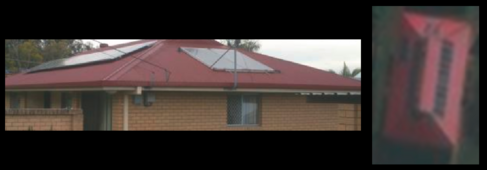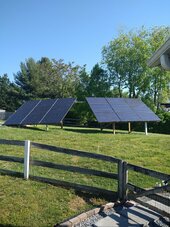ahreno
New Member
i'm about to draw out my system plans for permitting and had someone suggest facing one row east and one row west which threw me for a slight loop. I do like the idea of having more actual solar power later in the day. not sure about due east and west. maybe 15-20° off south? any thoughts?
My system:
26 408 watt panels with up to 142w bifacial gang
2 tesla powerwalls (one Powerwall 2, one powerwall +)
most likely 2 Growatt 7.6kW Grid-Tie inverters (not purchased yet)
Ground mount, 2 runs of 13 panels. shouldn't be any shading, pretty good view from East all the way to west
I'm in Norcal, PGE and will be on NEM3.0 which pretty much sucks from what i understand.
I dont know if it matters, but i think i was able to figure out my average hourly usage over the last 5 months (before that i was growing weed so the numbers are not relevant to use)
|0:00|1.43 kWh|
--:|--:|
|1:00|1.17 kWh|
|2:00|1.21 kWh|
|3:00|1.14 kWh|
|4:00|1.23 kWh|
|5:00|1.22 kWh|
|6:00|1.45 kWh|
|7:00|1.25 kWh|
|8:00|1.86 kWh|
|9:00|1.67 kWh|
|10:00|1.68 kWh|
|11:00|1.57 kWh|
|12:00|1.89 kWh|
|13:00|1.55 kWh|
|14:00|1.73 kWh|
|15:00|1.20 kWh|
|16:00|1.78 kWh|
|17:00|1.86 kWh|
|18:00|1.85 kWh|
|19:00|1.66 kWh|
|20:00|1.75 kWh|
|21:00|1.42 kWh|
|22:00|1.50 kWh|
|23:00|1.00 kWh|
My system:
26 408 watt panels with up to 142w bifacial gang
2 tesla powerwalls (one Powerwall 2, one powerwall +)
most likely 2 Growatt 7.6kW Grid-Tie inverters (not purchased yet)
Ground mount, 2 runs of 13 panels. shouldn't be any shading, pretty good view from East all the way to west
I'm in Norcal, PGE and will be on NEM3.0 which pretty much sucks from what i understand.
I dont know if it matters, but i think i was able to figure out my average hourly usage over the last 5 months (before that i was growing weed so the numbers are not relevant to use)
|0:00|1.43 kWh|
--:|--:|
|1:00|1.17 kWh|
|2:00|1.21 kWh|
|3:00|1.14 kWh|
|4:00|1.23 kWh|
|5:00|1.22 kWh|
|6:00|1.45 kWh|
|7:00|1.25 kWh|
|8:00|1.86 kWh|
|9:00|1.67 kWh|
|10:00|1.68 kWh|
|11:00|1.57 kWh|
|12:00|1.89 kWh|
|13:00|1.55 kWh|
|14:00|1.73 kWh|
|15:00|1.20 kWh|
|16:00|1.78 kWh|
|17:00|1.86 kWh|
|18:00|1.85 kWh|
|19:00|1.66 kWh|
|20:00|1.75 kWh|
|21:00|1.42 kWh|
|22:00|1.50 kWh|
|23:00|1.00 kWh|





